Introduction
Every customer goes on a journey before making a purchase decision. This journey is not random—it follows a clear path that marketers have studied and optimized for decades. That path is what we call the Marketing Funnel.
In today’s competitive digital landscape, understanding how consumers move from simply knowing about your brand to actually purchasing your product is vital for any marketer. Whether you’re a beginner or building your brand strategy, understanding this funnel can help you guide your audience from curiosity to conversion. At TheBrandWire, we believe marketing should be simple, smart, and strategic. Let’s break down the funnel stages so you can start applying them to your business or personal brand.
The funnel is typically divided into several stages: Awareness, Interest, Consideration, Intent, Evaluation, and Conversion. Let’s explore each stage in depth.
What Is the Marketing Funnel?
The marketing funnel is a model that illustrates the process a potential customer goes through before buying. It’s shaped like a funnel because at the top, you attract a large number of people, and as they move down, only a smaller group becomes paying customers.
The main stages are:
- Awareness
- Interest
- Consideration
- Conversion
- (Optional: Loyalty & Advocacy)
Let’s explore each step.
1. Awareness
This is the top of the funnel, where potential customers first learn about your brand, product, or service. At this stage, the goal is to attract as many people as possible.
Goal: Get noticed.
Tactics:
- Social media posts
- SEO-optimized blog content
- Influencer mentions
- Paid ads (Google, Instagram, etc.)
2. Interest
Once awareness is established, the next step is to build interest. Here, potential customers begin exploring more about your brand.
Goal: Engage and educate them.
Tactics:
- Value-packed blog posts (like this one!)
- Free guides or lead magnets
- Email opt-ins
- Behind-the-scenes content
3. Consideration
In this stage, users are comparing your offerings with competitors. They are actively evaluating options and are more likely to engage with content that helps them decide.
Goal: Nurture the relationship.
Tactics:
- Case studies and testimonials
- Webinars or live Q&As
- Product comparison posts
- Email sequences
4. Conversion – Sealing the Deal
The final step is converting the interested user into a paying customer. This is where your marketing and sales efforts come to fruition.
Goal: Make purchasing easy and appealing.
Tactics:
- Special discounts or limited offers
- Smooth checkout experience
- Clear CTAs (calls-to-action)
- Personalised support/chat
5. Loyalty & Advocacy – Turning Customers into Loyal user
While not part of the original funnel, modern marketers extend it to include loyalty.
Goal: Keep them coming back—and bringing others.
Tactics:
- Post-purchase emails
- Loyalty programs
- Referral bonuses
- Engaging community content
| Stage | Funnel Level | What It Means | Goal | Content Examples |
|---|---|---|---|---|
| Awareness | TOFU | New visitors find you | Grab attention | Reels, Blogs, SEO content |
| Interest | MOFU | They want to learn | Build trust | Emails, Guides, Webinars |
| Desire | MOFU | They’re evaluating | Create emotional buy-in | Testimonials, Comparison Posts |
| Action | BOFU | They’re ready to act | Convert & Close | CTAs, Landing pages, Sales emails |
Final Thoughts
Understanding the marketing funnel helps you serve the right message at the right time. From awareness to conversion—and beyond—each stage is a chance to build trust and drive action. By identifying where potential customers drop off, marketers can implement targeted strategies to guide them smoothly through the funnel.
At TheBrandWire, we’ll keep simplifying these big ideas so you can confidently grow your brand or business.





